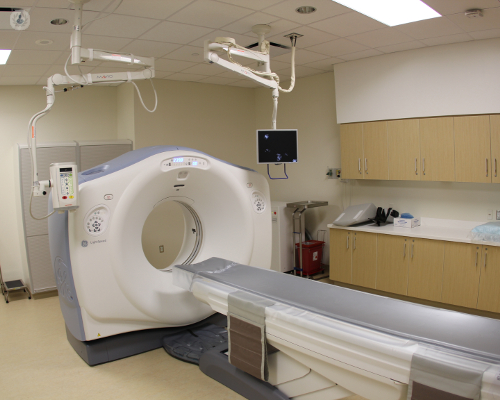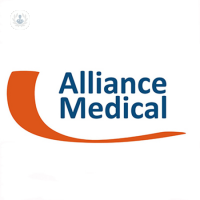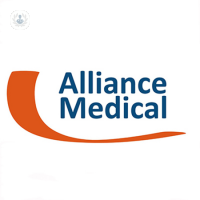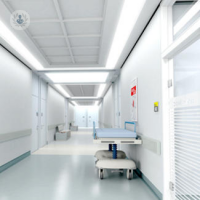CT scan (CAT)
Dr Gulraiz Ahmad - Radiology
Created on: 04-12-2018
Updated on: 02-23-2024
Edited by: Sophie Kennedy
What is a CT scan?
A computerised tomography (CT) scan, also known as a CAT scan, works by combining numerous X-ray images that are taken from different angles and processing them through a computer to produce a cross-sectional image of different parts of the body. These images are in black and white.
CT scans can be used to take images of bones, blood vessels and soft tissues and provide much more detail than regular X-ray images. These images may also be combined to produce 3D images of a particular area of your body. You can have a CT scan at a hospital or an imaging centre.

What does a CT scan involve?
CT scans are carried out in just a few minutes, and can take up to thirty minutes to complete. During a CT scan, you lie down on a table that slides in and out of the CT machine. You rest your head on a pillow and you may be strapped to the table to help you stay in position. If your head is being scanned, a special head cradle might be used.
As the table moves you into the CT machine, the ring (composed of the X-ray tube and detectors) rotate around you - producing images of your body - without surrounding your whole body at once. Buzzing and whirring noises may be heard. Whilst you are being scanned, the CT scan technician (called a radiographer) stays in an adjacent room and will communicate with you via intercom.
In some instances, you might be given a contrast dye, which blocks X-rays and appears white on images, highlighting certain tissues (for example, blood vessels or intestines) for the radiographer. This contrast dye is administered before the scan, as a drink, an injection, or an enema. There is a small chance you could have an allergic reaction to it.
During the scan, your body is briefly exposed to a low dose of ionizing radiation. This is a greater amount than that produced by a regular X-ray, because a CT scan gathers more detailed information about you. Depending on how much of your body is scanned, the amount of radiation you're exposed to varies. After the procedure, you could be asked to rest for a short time before returning to your daily activities to ensure that you're feeling well after the scan. Drink plenty of fluids if you were given contrast dye to help your kidneys remove the material from your body.
What is a CT scan for?
A CT scan is often used for diagnostic reasons, for example, they are used a lot when dealing with patients who have been injured and might have internal damage. Usually, CT scans aren't used for screening, unless it is coronary heart disease or certain types of cancer.
A CT scan is also used for the following:
- To locate a tumour or blood clot and assess its size, shape and composition
- To check if a tumour is close to nearby organs
- To guide procedures, such as surgery, biopsies or radiation treatment, abscess drains
- To diagnose bone and muscle disorders
- To determine if there is any internal bleeding present
- To monitor how effectively a treatment is working, during and after as part of the follow up care
- To examine conditions affecting the heart and its blood vessels (coronary CT scan)
How can you prepare for a CT scan?
It may be necessary to remove certain clothes and accessories before a CT scan, depending on which part of the body is being scanned, and asked to wear a hospital gown instead. Usually you will have to avoid food and drink a few hours before having a CT scan.
What does it feel like during a CT scan?
A CT scan is painless; however, it usually requires you to remain very still, which can sometimes be challenging, particularly if the patient is a child or in pain. Movement can blur the images, so it is important to stay still during the scan. Sometimes the patient can be given a mild sedative to help them relax.
If you're pregnant, you may be advised to perform another type of exam, like an ultrasound or MRI, to avoid exposing the baby to radiation - even though it's unlikely to cause negative effects. If you have allergies, kidney issues, or taking medication for diabetes, you should contact the hospital before the date of the CT scan, as special arrangements need to be made.
What happens with the results?
Results won't be available immediately. This is because a computer will need to process and prepare the information from the scan. A radiologist (a specialist in interpreting images of the body) will analyse the images and then write a report to be sent to your doctor, who will discuss the results with you. This process can take a few days or weeks.
How much does a CT scan cost?
Most medical insurance policies cover CT scans. The cost of a CT scan depends on the number of areas being scanned, whether contrast dye is needed, and the hospital or imaging centre.
Are a CT scan and an MRI the same?
While a CT scan and an MRI are both imaging methods, an MRI scanner uses radio waves and a strong, constant magnetic field to create images of the body's internal structures. No radiation is used. MRIs also produce more detailed images, but they are costlier and more time-consuming than CT scans. Patients with a pacemaker, stent or implant, should let their technician know of its existence and ensure that the metal is MRI-safe. Any type of metal device that interacts with the magnetic field risks being attracted to the magnet.








